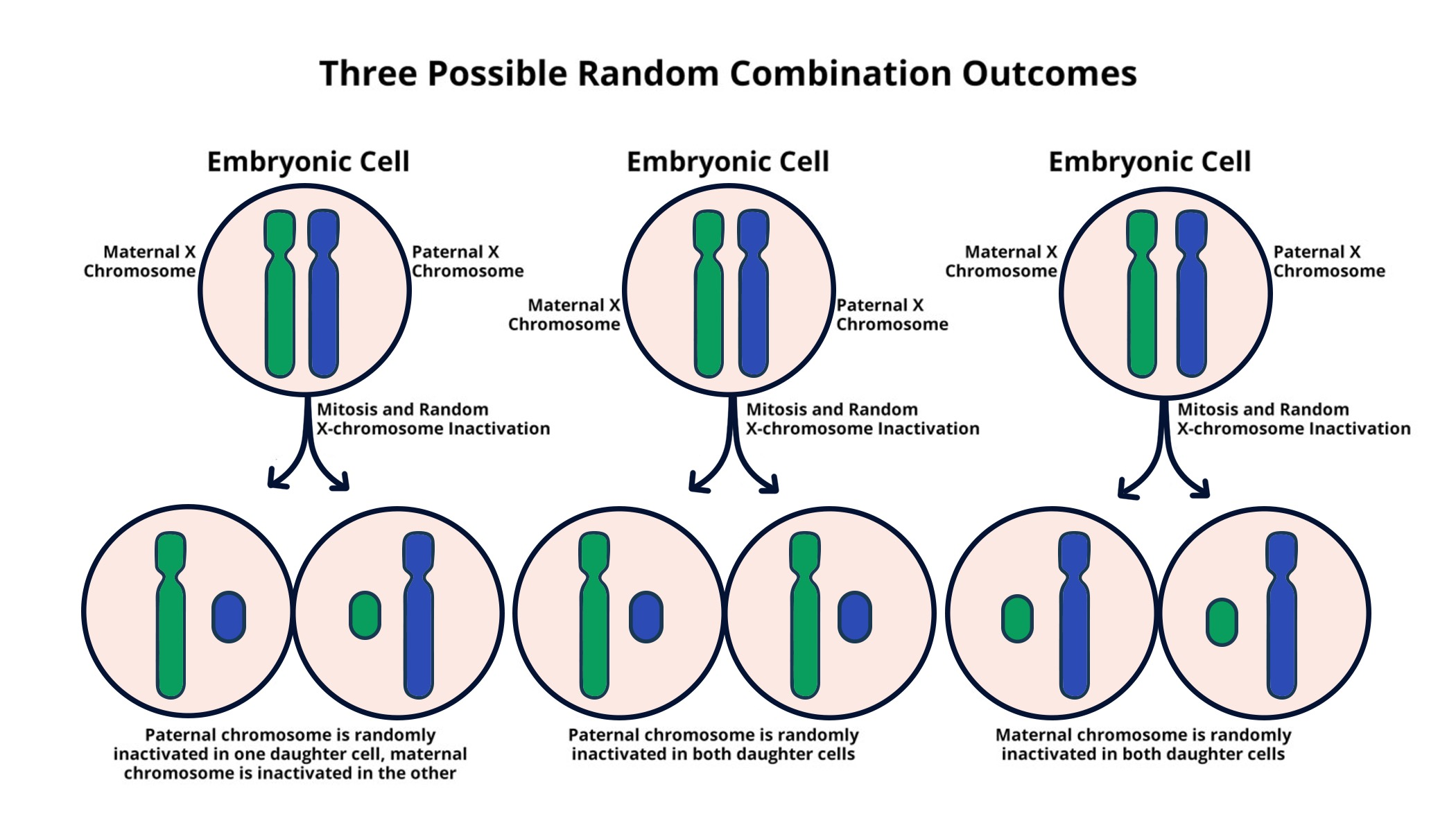X chromosome inactivation is a fascinating genetic process that serves as a critical solution to the genetic burden faced by female cells. Unlike males, who have one X chromosome, females possess two, leading to the necessity of silencing one X chromosome to prevent an overdose of genes encoded on it. This intricate mechanism of chromosomal silencing has significant implications for understanding genetic disorders like Fragile X Syndrome and Rett Syndrome, conditions closely linked to mutations on the X chromosome. Researchers, including those in Jeannie T. Lee’s lab, are unveiling the robust mechanisms of X inactivation, which could pave the way for groundbreaking gene therapy approaches that target these disorders. Understanding this process not only sheds light on cellular operations but also offers hope for therapies aimed at treating various X-linked genetic disorders, enhancing the quality of life for those affected.
The process of X chromosome silencing, often referred to as X inactivation, presents a remarkable solution to the unique genetic mosaic seen in females. With two X chromosomes, the challenge lies in managing gene dosage to ensure that gene expressions remain balanced. Advances in genetics are revealing how this chromosomal regulation can potentially unlock new treatments for disorders such as Fragile X and Rett syndromes. Recent studies highlight the role of specific RNA molecules and other components in orchestrating this delicate interplay of chromosomal control, which may lead to innovative gene therapy strategies. As researchers continue to explore the nuances of this essential biological process, we may soon see significant breakthroughs in the management of various chromosomal-linked genetic disorders.
Understanding X Chromosome Inactivation
X chromosome inactivation (XCI) is a crucial biological process that occurs in female mammals, allowing for the dosage compensation of X-linked genes. In each cell, one of the two X chromosomes is randomly silenced, which ensures that females, like males, have a single functional copy of the genes located on the X chromosome. This complex mechanism is guided by various molecular players, including the Xist RNA molecule that plays a significant role in shaping the chromatin landscape around the X chromosome. The intricate orchestration of XCI is essential in maintaining genetic balance, particularly in the context of genetic disorders that arise from mutations on the X chromosome.
Research into X chromosome inactivation has revealed much about how cells regulate gene expression and maintain genomic stability. The gelatinous structure surrounding chromosomes, often likened to Jell-O, contributes significantly to this process. It facilitates the selective silencing of genes, helping to prevent potential genetic overexpression. Advances in understanding XCI not only solve fundamental questions in genetics but also pave the way for developing therapeutic strategies aimed at targeting disorders such as Fragile X Syndrome and Rett Syndrome.
Implications for Genetic Disorders
The discovery of how X chromosome inactivation functions opens doors to innovative treatment options for genetic disorders linked to the X chromosome. Fragile X Syndrome, characterized by intellectual disability and developmental delays, is a prime example where XCI knowledge can aid in developing gene therapy. By understanding the mechanisms that silence mutated genes, researchers can work to reactivate healthy versions of these genes. This line of therapy is especially promising as it may have direct implications not just for female patients but also for males who have the disorder due to specific mutations.
Moreover, Rett Syndrome, another X-linked disorder, is impacted by the same XCI principles. The ability to potentially unsilence genes that are inactivated allows for restoring normal function in affected individuals. This therapeutic avenue not only aims to alleviate symptoms but also to address the underlying genetic causes of these conditions. The translation of laboratory research into clinical applications represents a significant advancement in the treatment of X-linked genetic disorders, signifying hope for many affected families.
The Role of Gene Therapy in Treating Genetic Disorders
Gene therapy has emerged as a beacon of hope in the domain of genetic disorders, particularly those that afflict the X chromosome. Through the innovative techniques developed by research teams like that of Jeannie T. Lee’s, the possibility of correcting genetic anomalies at their source becomes increasingly feasible. Utilizing methodologies that target and reactivate silenced genes holds the potential to reverse the effects of devastating conditions such as Fragile X Syndrome and Rett Syndrome. Overall, gene therapy exemplifies how advances in our understanding of epigenetic mechanisms can lead to revolutionary treatment approaches.
As research continues to evolve, integrating gene therapy within the broader context of genetic engineering brings with it additional considerations about safety and efficacy. The efficacy of these therapies depends on precisely understanding the genetic architecture involved in disorders and ensuring they do not unintentionally disrupt the normal functioning of healthy genes. Given the nuanced nature of X chromosome inactivation, further studies are necessary to optimize delivery methods and treatment protocols to ensure successful outcomes for those afflicted with these challenging genetic conditions.
Challenges in X Chromosome Gene Reactivation
Although the potential for unsilencing the X chromosome brings optimism, challenges remain in effectively reactivating genes without adverse effects. For instance, while researchers have found that freeing inactivated genes can restore function, the reason healthy genes remain unaffected needs deeper investigation. Understanding the limitations of gene expression capacity in cells is essential. This knowledge could help in designing more targeted therapies that selectively influence mutated genes while preserving the expression of those that are already functioning correctly.
Moreover, clinical applications based on X chromosome gene reactivation face hurdles in translating lab findings into viable treatments. Safety studies and regulatory processes are fundamental steps that require rigorous testing to ensure that newly developed therapies do not cause unforeseen complications. As the scientific community continues to uncover the intricacies of XCI and its implications, the focus must remain on developing reliable, safe, and effective forms of therapy that can truly enhance the quality of life for individuals affected by genetic disorders rooted in X chromosome mutations.
Research Advances and Future Directions
The ongoing research led by Jeannie T. Lee’s lab signifies an important step forward in genetics and gene therapy. After decades of exploration into the mechanisms of X chromosome inactivation, the revelation that it may be possible to reactivate certain genes is promising for the future of treating genetic disorders. The ability to manipulate and restore gene function could potentially revolutionize the management of diseases like Fragile X Syndrome and Rett Syndrome, offering new hope to those impacted by these conditions.
Future directions in this field will focus on refining gene therapy techniques and exploring the full spectrum of potential effects on cellular systems. Understanding the precise interactions between Xist RNA and the surrounding chromatin environment will be crucial for optimizing therapeutic approaches. The next few years are critical as researchers work on transitioning laboratory successes into clinical trials, showcasing the potential of targeted gene therapies in correcting genetic disorders and, in doing so, potentially changing the landscape of treatment for many.
The Future of Chromosomal Silencing Research
As researchers delve deeper into understanding chromosomal silencing mechanisms, the future of genetics appears promising with innovative therapeutic strategies. The insights gained from studying X chromosome inactivation not only illuminate the complexities of X-linked genetic disorders but also provide a framework for exploring silencing processes across other chromosomes. Understanding the fundamental principles of chromosomal regulation can pave the way for developing broader gene therapies that address an array of genetic conditions beyond just those involving the X chromosome.
Furthermore, the research trajectory is shifting towards harnessing advancements in technology, such as CRISPR-Cas9 gene editing and next-generation sequencing. These tools enable precision targeting and manipulation of genes, which could optimize the outcomes of therapies targeting X-linked disorders. As researchers continue to refine these methodologies and their applications, the potential to alleviate the burden of genetic disorders seems more attainable than ever. Therefore, the connection between basic biological research and therapeutic development is strengthening, fostering an environment where innovation in genetic medicine can thrive.
Significance of Epigenetics in Gene Regulation
The intersection of epigenetics and gene regulation exemplifies how factors beyond DNA sequence directly influence gene activity. Epigenetic mechanisms such as DNA methylation and histone modification are paramount in controlling gene expression, particularly in contexts such as X chromosome inactivation. Understanding these processes offers profound insights into how environmental factors and cellular context can shape genetic outcomes, thus broadening the scope of therapies being developed. The gelatinous ‘Jell-O’ structure surrounding chromosomes illustrates the vital role of epigenetics in maintaining chromosomal integrity and regulating gene silencing.
Exploring the nuances of epigenetic regulation further highlights the complexity of designing effective treatments for genetic disorders. For example, therapies aiming to unsilence mutated genes must consider the epigenetic landscape surrounding those genes. A holistic understanding of the epigenetic mechanisms at play informs the development of targeted approaches that could ameliorate the effects of genetic diseases while minimizing potential side effects. As the field continues to evolve, the significance of epigenetics remains at the forefront of genetic research and therapeutic development.
Impact of Chromosomal Discoveries on Genetic Therapy
Recent discoveries regarding X chromosome inactivation and chromosomal properties have substantial implications for the field of genetic therapy. These findings provide a foundation upon which novel therapeutic strategies can be constructed, particularly for diseases linked to the X chromosome. By revealing how chromosomal silencing can be manipulated, researchers are better equipped to develop targeted treatments for conditions like Fragile X Syndrome and Rett Syndrome. This therapeutic potential underscores the importance of continued research in understanding gene regulation mechanisms.
Moreover, the potential applications of chromosomal discoveries extend beyond X-linked conditions. The principles derived from studying XCI can apply to other genetic disorders, enabling a more expansive approach to treatment development. As researchers build upon these foundational insights, there is hope for breakthroughs that can address a broader spectrum of genetic disorders. This underscores the importance of interdisciplinary research efforts that can bridge the gap between basic science and clinical application, ultimately leading to innovations that improve patient outcomes in genetic medicine.
Concluding Thoughts on Chromosomal Research and Its Future
In conclusion, the advancements made in understanding X chromosome inactivation and its therapeutic implications present both opportunities and challenges. The ongoing research in this domain highlights how fundamental science can translate into meaningful clinical applications that hold the promise of improving lives affected by genetic disorders. As scientists continue to decipher the complexities of gene regulation, the potential for developing effective therapies grows, setting the stage for a new era in genetic medicine.
Looking ahead, it is essential for research to not only focus on the immediate therapeutic applications but also on understanding the broader implications of these findings for future genetic studies. The interplay between genetic makeup, environmental factors, and epigenetic modifications shapes the landscape of genetic disorders and their treatments. Thus, as we unravel the mysteries of chromosomal function and regulation, we pave the way for pioneering approaches in managing and possibly curing genetic conditions.
Frequently Asked Questions
What is X chromosome inactivation and how does it relate to genetic disorders like Fragile X Syndrome?
X chromosome inactivation is a biological process occurring in females where one of the two X chromosomes is inactivated to prevent overexpression of X-linked genes. This process is crucial in preventing genetic disorders, such as Fragile X Syndrome, which is caused by mutations on the X chromosome. By silencing one X chromosome, females balance gene expression, but if mutations occur, the healthy version on the inactive chromosome may not be utilized.
How does chromosomal silencing contribute to conditions like Rett Syndrome?
Chromosomal silencing refers to the mechanisms by which certain genes on the X chromosome are turned off, crucial for normal cellular function. In Rett Syndrome, mutations can disrupt this silencing process, particularly affecting gene expression regulation. Research into X chromosome inactivation may reveal potential therapeutic strategies to restore gene function and offer relief from symptoms associated with Rett Syndrome.
What role does the Xist gene play in X chromosome inactivation?
The Xist gene produces an RNA molecule that initiates the process of X chromosome inactivation. This molecule coats the X chromosome and modifies the surrounding chromosomal environment, facilitating the silencing process. Understanding Xist’s function is key to developing gene therapy strategies aimed at treating disorders linked to X chromosome mutations.
Can gene therapy help reverse X chromosome inactivation for conditions like Fragile X and Rett Syndrome?
Yes, gene therapy holds promise in reversing X chromosome inactivation for genetic disorders such as Fragile X Syndrome and Rett Syndrome. Research has shown that it is possible to ‘unsilence’ the inactive X chromosome, restoring the function of healthy genes. This therapeutic approach could significantly improve the quality of life for affected individuals.
What breakthroughs have been made in understanding X chromosome inactivation?
Recent breakthroughs in understanding X chromosome inactivation include discoveries about the biophysical properties of chromosomal silencing substances, like the gelatinous material surrounding chromosomes. Researchers, including Jeannie T. Lee’s team, have identified how molecules like Xist influence this environment, which could pave the way for novel treatments for X-linked genetic disorders.
How does X chromosome inactivation affect males differently compared to females in relation to X-linked disorders?
Males have only one copy of the X chromosome and do not undergo X chromosome inactivation like females. Instead, if they carry mutations on the X chromosome, they are fully expressed, which can lead to the manifestation of X-linked disorders such as Fragile X Syndrome. Understanding this difference is crucial in developing treatments that address both sexes effectively.
What is the significance of continuing research on X chromosome inactivation for future therapies?
Research on X chromosome inactivation is significant as it uncovers the fundamental mechanisms governing gene expression regulation. Understanding these processes is vital for developing targeted therapies for genetic disorders like Fragile X Syndrome and Rett Syndrome. Advances in this field could lead to innovative treatments that not only restore gene function but also minimize side effects.
| Key Points |
|---|
| The X chromosome presents unique challenges, especially in female cells that possess two X chromosomes. |
| X chromosome inactivation (XCI) is essential to balance gene dosage between sexes, leading to silencing of one X chromosome in females. |
| Jeannie T. Lee’s research group has been pivotal in uncovering mechanisms of XCI and its implications for genetic disease. |
| Recent findings highlight that a gelatinous substance around chromosomes plays a crucial role in orchestrating XCI. |
| Xist RNA is key to altering the properties of this substance, facilitating the inactivation process. |
| Advancements in reversing XCI could provide therapeutic avenues for Fragile X and Rett Syndromes. |
| Lee’s team aims to initiate clinical trials after optimizing their methods and confirming safety. |
| Successful reversal of XCI could potentially have minimal side effects on otherwise healthy genes. |
Summary
X chromosome inactivation is a critical biological process that balances gene expression in females who carry two X chromosomes. This phenomenon has significant implications for understanding and potentially treating genetic disorders linked to mutations on the X chromosome. The groundbreaking research conducted by Jeannie T. Lee’s laboratory sheds light on the complex mechanisms behind XCI, particularly the role of the Xist RNA and its interaction with a gelatinous substance surrounding chromosomes. As breakthroughs in reversing XCI continue, there is hope for innovative therapies that could alleviate conditions such as Fragile X Syndrome and Rett Syndrome, offering new possibilities for patients affected by these genetic disorders.




